Incidents underscore need to remain vigilant
Published February 24, 2016
A series of scary incidents over the last few weeks in the St. Louis Jewish community as well as in Jewish communities elsewhere have forced local organizations and institutions to test their security plans.
Saul Mirowitz Jewish Community School in Creve Coeur was one of a number of Jewish schools nationwide to receive a bomb threat on, or around, Feb. 9. A day earlier, eight such schools in Great Britain also received threats.
Then last Friday, Feb. 19, a man and woman entered the Jewish Community Center Millstone Campus and asked suspicious questions to a security guard at the St. Louis Holocaust Museum and Learning Center. The man said he was carrying a “concealed weapon”; video footage reviewed later showed the couple had been videotaping the campus.
ADVERTISEMENT
The incidents serve as a reminder that Jewish organizations and institutions must always take precautions to ensure the safety of participants, even if the perpetrators were only trying to incite fear rather than stage an attack, Jewish leaders and the police say.
“You take as many precautions as you can and have as many security layers as possible, and if it turns out you don’t need them, fine,” said Karen Aroesty, regional director of the Anti-Defamation League of Missouri and Southern Illinois.
After receiving the bomb threat, the staff at Saul Mirowitz evacuated the building and led students to nearby safe houses. The police are continuing to do extra patrols of the property, which includes Congregation B’nai Amoona.
ADVERTISEMENT
“We routinely visit them and go over their safety plans, and work with them to make any improvements,” said Tim Koncki, Creve Coeur police public information officer. “They are very proactive in that.”
The FBI and police in Creve Coeur and other cities that have received bomb threats are continuing to investigate the calls — and determine possible connections among them. But officials say they don’t have any leads because they have not been able to trace the calls, which came from international numbers.
Those sort of phone calls, or ones in which callers use a “burner” phone, which is not associated with a particular person, are difficult to prevent, said Michael McGrath, superintendent of the Lower Merion Police Department near Philadelphia, Pa. Perelman’s Jewish Day School in Wynnewood, Pa. was one of the schools to receive a bomb threat Feb. 9.
The phone calls are meant to cause “fear and disruption,” McGrath said.
St. Louis County police have filed a peace disturbance report and notified the FBI in case the couple at the Millstone Campus were planning a future attack, according to Shawn McGuire, a public information officer for the county police.
The police reviewed footage of the couple approaching the Holocaust museum and noticed the man doing a Nazi salute. The man also told a security guard standing outside the museum he was carrying a “concealed weapon,” and asked him whether you had to be Jewish to visit the museum. The guard told him he needed to put the weapon back in his car, according to police. The man then left with his woman friend in a silver and black SUV.
The male suspect was described as 6-foot-1 inch, white, weighing about 250 pounds with short-cropped brown hair. The woman is a white female, weighing more than 170 pounds with a red or brown ponytail.
“They may have bad intentions,” said McGuire. “They may just be immature, weird people, but we just can’t take anything lightly.”
Despite the spate of bomb threats against Jewish schools, the perpetrators were not necessarily targeting the Jewish community, Aroesty said. Over the last month, dozens of schools in Australia have been evacuated after receiving bomb threats. A number of public schools in the Boston area also received bomb threats earlier month.
“I think it’s too early to draw any conclusions about intent,” Aroesty said.
But Jewish institutions should still evaluate their security and consider how people access their buildings or how far they get before confronted with some level of security, Aroesty said. It has been almost two years since Frazier Glenn Miller killed three people in parking lots outside of the Jewish Community Center of Greater Kansas City and Village Shalom, a nearby Jewish retirement community.
Despite the threats, some people may be concerned about overreaction and implementing heavy security. For example, people affiliated with organizations are sometimes reluctant to ask visitors questions or to see some identification, Aroesty said.
“They don’t perceive it as warm and welcoming. But warm and welcoming and strong security awareness go hand in hand. They are not separate from each other,” Aroesty said.
Jewish Federation of St. Louis President and CEO Andrew Rehfeld described the organization’s building, which includes the Holocaust museum, as having “very good security.” He also said that the Federation had implemented a communication system about nine months ago that alerts local Jewish communal organizations about possible threats so that “people can be situationally aware. It’s the single best way to keep the community safe,” he said.
The recent incidents are alarming, but “a fact of today’s situation,” Rehfeld added.
“In both cases, nothing happened and in both cases our community responded in a way that was best practices to keep people secure, and we will continue to do that,” he said. “The vast majority of these threats are just that, to create a fear response rather than simply to harm people.”

















